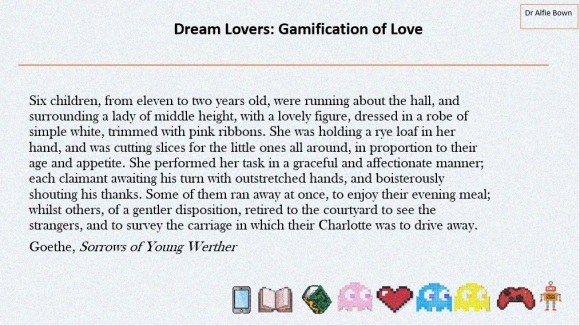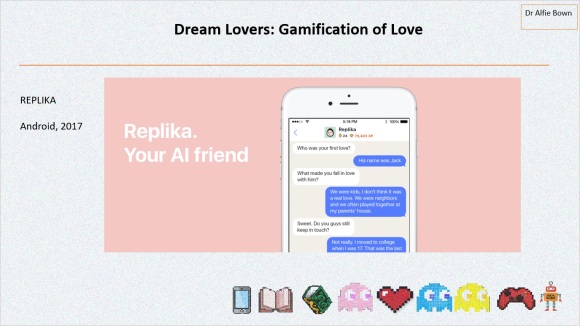I originally wrote and published this post on the Landscape Surgery blog of the Social, Cultural and Historical Geography Research Group in the Department of Geography at Royal Holloway, University of London. Landscape Surgery is a fortnightly seminar series that the SCHG hosts during term-time. Sessions are typically organised around a theme for which speakers (including external invitees) talk about their research, followed by questions/general discussion on the topic; though it can also include workshops and research training sessions. I attend the sessions as part of my PhD activities, and am one of four editors of the Landscape Surgery blog.
The session discussed in this post was organised around the theme of 'The Digital Libidinal City', with a presentation by Alfie Bown on how desire is mediated in the smart city, followed by responses by myself and Megan Harvey. Thanks to Alice Reynolds for editing this post.
---------------------------------------------------------
Our final Landscape Surgery session of the Spring term, The Digital Libidinal City, delved into the topic of desire and digital media in contemporary urban life. For this session we welcomed Alfie Bown, lecturer in the Media Arts department at Royal Holloway, author of The Playstation Dreamworld (2017) and Enjoying It: Candy Crush and Capitalism (2015), and contributor to The Guardian and The Paris Review. Acting as discussants for Alfie’s presentation were Jack Lowe and Megan Harvey, PhD students in the Department of Geography and members of the department’s Social, Cultural and Historical Geographies Research Group.
Seeking in his presentation to frame the smart city as the scene for relationships of love and desire, Alfie introduced his presentation by pointing to past representations of desire in the early Romantic literature, in which love is framed as a scene composed of objects arranged with semiotic significance in the urban environment. Unlike ‘love at first sight’, the love experienced by the narrators of Charles Baudelaire’s poetry, or Johann Wolfgang von Goethe’s The Sorrows of Young Werther, is not a single moment of encounter between a subject and their desired object, but rather ‘love at last sight’ – the broader scene in which desire is activated.

In thinking about this scenography of desire, Alfie finds value in Roland Barthes’ work on semiotics, which examines how objects are organised into meaningful relationships that reflect wider cultural values. Alfie contended that desire in today’s digitally-mediated cities is evoked through the same process – through the arrangement of objects using interfaces, not just a singular association between subject and object of desire. Whether the desire is for a lover (e.g. Tinder, Grindr), food (e.g. Uber Eats) or something entirely fictional (e.g. Pokémon GO), the moment when this desire begins is the point at which a new relationship between the subject and implicated objects is formed – and increasingly these relationships are mediated through the digital technologies of smartphone applications, artificial intelligence (AI) and data profiling.
To illustrate his argument, Alfie presented three examples of contemporary smartphone apps that mediate this arrangement of objects using data, in an attempt to produce ‘desirable’ outcomes.
Replika is an AI chatbot that learns what the user wants in a friend by asking them a series of questions. Alfie explained that even if the user chooses to submit the bare minimum of personal information in advance, the chatbot can learn a great deal of personal information by offering the kind of helpful conversation that a supportive friend would provide, “a space where you can safely share your thoughts, feelings, beliefs, experiences, memories, dreams”. Replika is consequently marketed as the “the AI companion who cares”.

Shapr is an app that uses LinkedIn data to suggest connections that could be relevant to your career. Its algorithm recommends 15 people each day that you may want to connect with, which users then swipe through to determine who they are keen to meet or not. If the interest to connect is mutual, users can organise to meet each other in person through the app’s messaging system. Through this activity, the app claims to help people “find inspiration and new opportunities” and “make professional networking simple, efficient and enjoyable for everyone”.
Lastly, Serendipity is an app that alerts the user when they happen to be near another person with a similar data profile. Based on the idea that there are only six degrees of separation connecting everybody on earth, the app encourages users to meet new people and find out who you know or what you have in common, so that you will “never miss a connection again”. Among other features, the app also allows you to track friends you are meeting with (if they are late), or those who are part of your group (if they are lost). All that is required for these services is for users to import all their contacts, and the app will do the rest.
These three apps, Alfie suggested, demonstrate the close interrelationship between objects of various forms that are represented through interfaces, and the desires that manifest in urban life today – for companionship and personal support, for making relevant professional contacts, and for expanding your network of friends and acquaintances.
While none of the outcomes of these three apps may seem particularly concerning at face value, Alfie warned that the purposes of digital media like these can easily expand beyond modelling and predicting user characteristics and actions, to actively manipulating their behaviours. While working in Hangzhou in eastern China, Alfie learned about the development of AI cars powered by Alibaba’s big data lab City Brain, which can respond to passenger needs. Not only do the cars use data generated by the user’s patterns of behaviour and language to tell you when you are hungry, but they can tell you exactly what you want to eat, taking you directly to the food outlet serving what you desire. This is an example of smart technology directly changing how users navigate the city and, most disturbingly, in a way that actively benefits one corporation over another.
Smart technology changing how we navigate the city is not a trend restricted to China’s smart cities. Alfie explained that Transport for London already has the technology to monitor where and when people are gathering, and could use these algorithms, and the data generated by passengers, to direct people along different routes using their journey planning services. Beyond applications that aim to move people more efficiently across the city, this technology could effectively play a role in, for example, preventing people from joining a political protest.
Elsewhere, manipulation of movement has entered the sphere of leisure activities. Alfie was in Hong Kong during the summer of 2016 when the hugely popular mobile game, Pokémon GO, was released worldwide. One Pokémon that was especially rare in those early months, Porygon, could only be obtained by visiting one particular shopping mall in the territory. With catching all the available Pokémon being one of the principal aims of the game, this meant that players were guided through the gameplay towards certain sites of consumption. Across many countries, this trend linking the mobile gameplay with locations of consumption has manifested through Pokéstops – in-game sites mapped onto physical landmarks where players can receive items in Pokémon GO – being sponsored by companies such as McDonald’s and Starbucks.

Through these different examples, Alfie aimed to demonstrate how three seemingly disparate desires of contemporary urban life – Pokémon, food and lovers – all share the same qualities algorithmically and conceptually, in that the interfaces through which these desires are mediated can be structurally organised in ways that are open to manipulation, particularly when it comes to how people navigate cities. What makes this risk even more prevalent is that people today often implicitly trust digital services and big data to make the best choices for them.
Alfie struck a different chord at the conclusion of his presentation, however, by indicating that there are possibilities for resisting and subverting the algorithmic manipulation of desire. In another Chinese city, Shenzhen, where Pokémon GO is banned (as it is across the mainland), people with the technological know-how have found a way to play the game by layering the in-game map of New York – a city whose streets share a similar grid layout – on top of the map of Shenzhen. Due to the inevitable differences between the street layouts, players would embrace methods of navigating the city that are socially unacceptable and on occasions dangerous: reaching particular Pokémon spawns and Pokéstops by climbing over fences, walls and train tracks, alongside other forms of trespass.
Perhaps, then, there are still opportunities for desire to be harnessed as a tool for asserting what we individually or collectively want in our increasingly digitally-mediated cities.
We would like to thank Alfie for sharing his path-breaking research with a geographical audience, and for helping to continue the strong relationship between the Geography and Media Arts departments at Royal Holloway.
This post is Part 1 of a three-part series based on The Digital Libinal City session. Part 2 will feature Jack Lowe’s response to Alfie’s presentation, which focused on the relationships between digital technologies and everyday urban experience, particularly in the form of video games and apps. Part 3 concludes the series with Megan Harvey’s discussion of the psychoanalytic dimensions of desire and its relationship with capitalist reproduction, dreamwork and subversion in the digital sphere.
No comments:
Post a Comment